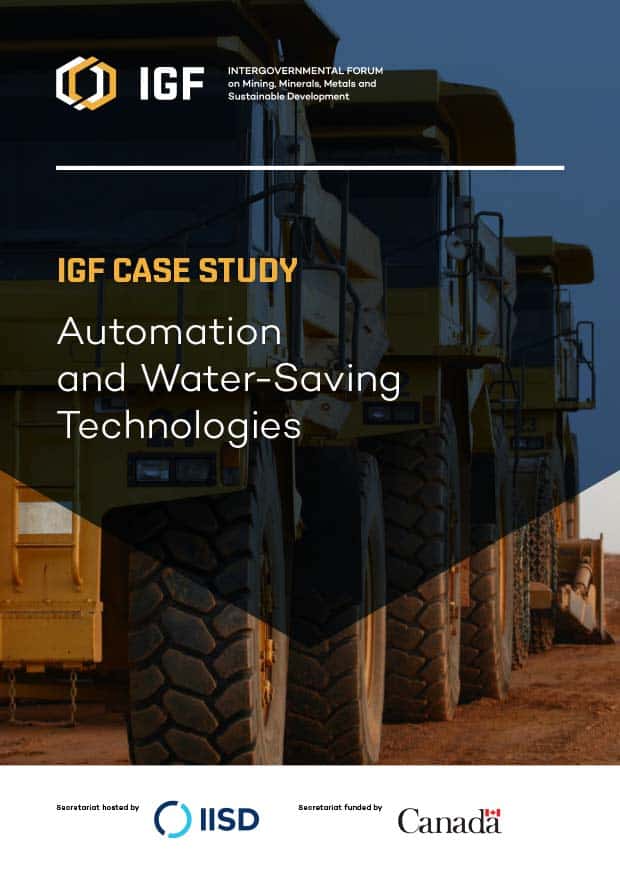New technologies in mining are changing the face of the industry at unprecedented speeds and scales. Mining processes are becoming smarter, leaner, more efficient and more flexible in terms of employment, but are they becoming more sustainable?
These changes not only reshape how mines operate around the globe, they will also transform the mining industry and the way people live, work and relate to machines and to their workplace. Technological changes in mining will also have implications for the relationships between industry (e.g. mining companies and suppliers) and host countries (including both governments and local communities).
IGF Case Study: Automation and Water-Saving Technologies explores emerging technological innovations being rolled out in Australia, Mali, and South Africa, the potential impacts of these technologies and how governments are responding to challenges. What did we find?
To understand the impacts, you need to see the trends
Before looking at the impacts of new technologies in mining, stakeholders must understand which technologies will have ground-breaking impacts on the sector. Enablers of digitalization such as smart sensors, big data trackers including blockchains, technologies which optimizes productivity or process such as automation, and technologies that improve process including clean technologies are the key trends governments and industry must grasp.
There is no one-size-fits-all approach
The impacts of technological changes in mining are difficult to predict, but what we do know is each scenario will differ depending on the context in which they are being deployed. For example, developed countries may be less impacted due to higher skill sets or a diversified economic base in comparison to developing countries, or investments in high-tech processes may vary based on the size of the mining company or lifespan of available resources.
We need to prepare for the future of work
Low-skilled, repetitive jobs will be displaced by positions requiring highly skilled employees or technical knowledge. A challenge will be to find a sufficient pool of labour to meet these new opportunities and prepare the labour force with the required skill sets. Although higher paid positions, this shift will require a review of the education system with an emphasis on science, technology, engineering and mathematics (STEM).
Changes in jobs highlight systemic challenges
Positions requiring highly skilled employees or technical knowledge could exclude already marginalized communities. At Pilbara’s mining operation in Australia, this highlighted a severe gap in Indigenous levels of education and skill sets. While technology still provides job opportunities, systemic challenges facing Indigenous communities’ access to education and other economic opportunities means they are being left out of mining’s technological evolution.
Investment in local economic development is needed
The shift in job availabilities will put pressure on the local labour market, resulting in the need for solutions in other economic sectors. Mining companies may need to shift towards corporate investment responsibility or impact investments to support local economic development. However, the onus wouldn’t be on industry alone. Mining companies could collaborate with governments to provide incentives or institutional support for investment activities to take place within broader industrial development strategies.
Game changing tech for less-advanced economies
The evolutions in technologies in mining will prove a challenge for many regions, but for less-advanced economies, these changes can also provide opportunities for local communities. If applied to technological infrastructure, the benefits of new tech can far outweigh the negative impacts in the medium to long term. In South Africa, abandoned mine sites pose threats to water quality while mining activities occurring in water-stressed communities can increase local unrest. Technologies aimed at improving water management, such as closed-loop water recycling, improved techniques for more accurate evaporation control, and dry tailings disposals can improve either the quality or quantity of available water.
For more information, please read IGF Case Study: Automation and Water-Saving Technologies. Stay tuned in the weeks and months to come as we launch the next case studies in the series, highlighting post-mining transitions, mining and Indigenous relations, and more.
This case study relates to our New Tech, New Deal project, which is supported by the Deutsche Gesellschaft für Internationale Zusammenarbeit (GIZ) GmbH, on behalf of the German Federal Ministry for Economic Cooperation and Development (BMZ).

